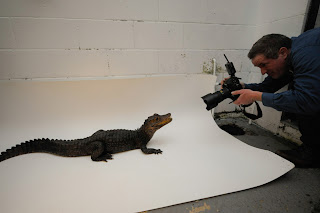 |
| Gray Gibbons |
In January of this year,
veteran National Geographic photographer, Joel Sartore (whose work was previously described here), began his latest
assignment. Dubbed The Great American Zoo Trip, Sartore was heading off to
eight different zoos to photograph endangered animals in portrait
situations so that people like you and me could better connect to them. In
the past five years, Sartore has collected 1800 photos of endangered
animals and he hoped to add another 25 to his collection.
In the first of 13 dispatches for the
project, Sartore said, “My job is to get you to look at them in a new way,
to understand that all of this complexity and beauty has been shaped by
millions of years of evolution. It would be a crime to doom even one of these
species to extinction. It may also threaten our very existence. It is folly to
think that we can doom everything else to extinction but that we’ll be just
fine.”
 |
| Musky Caiman |
Yet, this is a crime that we are committing. Not pointing any fingers but we humans, all 7
billion of us and counting, are consuming resources, converting natural areas
into farmland, polluting watersheds and the atmosphere, over-hunting and
over-fishing, introducing invasive species and altering the atmosphere. We are
sending 100 species per day to extinction.
Sartore also writes that zoos still have a substantial
“inventory.” Because many species don’t breed well in captivity, in the
past, zoos have been able to get replacements from the wild, but for some
species, the captives are all that are left. In a sense, zoos are becoming like
arks, preserving the last of their kind.
Reading the dispatches in the series, you see the important work
that zoos are doing to promote interest in animals, particularly endangered
animals. These are places where we can see live animals – not videos or webcams
– with our own eyes and admire their cuteness and quirks, their grace and
majesty, and establish a bond between human and animal.
 |
| Tawny Frogmouth |
The series is a crash course on animal behavior, from lions to
frogs (did you know that chimps like to throw their poop?) and you find out
that animals can be pretty finicky about stepping onto black or white portrait
paper. The shoots have to happen very quickly! But the final photos are
dazzling. The animals are by turns mischievous, pensive, playful, stoic and
majestic.
But the saddest part is hearing that when the world zoo
population of any animal slips below 50 individuals, tough choices have to be
made. If more individuals can be got from the wild, the species can go forward.
Otherwise, the animal will be “phased out.” Like the gray gibbon, pictured at top. There are too few left in the wild to bolster the population. So, soon
we’ll lose the gray gibbon.
Sartore also points out the incredible dedication zoo keepers
have for animals as well as those who work in wildlife recovery centers, who
help heal injured or diseased animals and get them back into the wild as
quickly as possible. They work with very little funding and could use whatever
support we can give them.
 |
| Spotted Hyenas |
That is the message of Sartore’s “Biodiversity Project”
(he’s inviting new names for it): the natural world is in danger and zoos are
providing life support for many unique and beautiful species. It’s up to us to
educate ourselves about endangered species; it’s up to us if we want to save
them.
Read all the dispatches here.
View a photo gallery from the collected dispatches is here.
 |
| Silkie Showgirl Chickens |
This piece was originally written for the good people at Explore.org -- click over there and see what they're up to!
thanks this
ReplyDelete